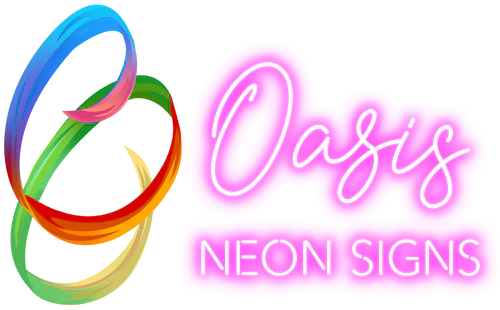
Fluorescent vs Neon: The Ultimate Comparison
Share
When it comes to the comparison of fluorescent vs neon, although they are similar, they differ in a few significant ways. The gas type utilized inside the glass tubes is the most significant of them. Numerous gases can be used with neon, either separately or in tandem. The atoms produce color when electricity is sent through them. While low-pressure mercury vapor is specifically poured into the glass tubes of every fluorescent light.
This emits UV light when current is sent through it. The energy can be converted to visible light by covering the interior of the tubing with phosphor. This happens because of the phosphor, which gives them their name, fluorescing.
In this post, we will compare neon vs fluorescent lights side by side, and then go into each technology individually.
Fluorescent Light
Fluorescent lights are popular for their energy efficiency and long lifespan. This section describes the specifics of fluorescent lights, their advantages and disadvantages.
What Is Fluorescent Light?
Gas-discharge lights, sometimes referred to as high-intensity discharge, HID, or arc lights, are one kind that includes fluorescent light bulbs. The compact fluorescent lamp is referred to by the acronym CFL.
Tubes for conventional fluorescent lights are manufactured; these tubes typically range in length from 48 to 84 inches. They are "compact," as the name suggests, they are still tubes. Due to its greater efficiency and longer lifespan than incandescent bulbs, CFLs were intended to replace them in conventional applications.
The fluorescent coating converts ultraviolet radiation into light. An electrical charge passed through the inactive mercury glass inside the lightbulb is what first produces the UV radiation. As a result of the electricity stimulating the gas, UV radiation is released. A third electrode, or extra metal component, inside the lightbulb, or a voltage pulse are usually used to produce the ignition needed for fluorescent lights.
With small tubes, starting is quite easy, while larger lights may need a lot of electricity. Additionally, fluorescent vs neon paint differs in brightness due to their different rates of energy consumption.

Before, fluorescent light bulbs needed to "warm up" for a while for the internal gas to turn into plasma. However, these days, fluorescent light may start almost immediately, thanks to several technologies, such as "rapid start," "instant start," and "quick start."
In addition, the light needs more electricity to function as it gets hotter. A ballast, which might be electrical in more modern fluorescent technology or magnetic in older fluorescent bulbs, balances the voltage required in fluorescent bulbs. When a fluorescent light gets more mature, it takes more voltage to create the same quantity of light until the voltage surpasses the ballast's fixed-resistance, and the light breaks. Since they require more voltage to generate equal lumen output when the light deteriorates, fluorescent lights lose efficiency over time.
Advantages of Fluorescent Lights
Having been in use for over a century, fluorescent technology is thought of as a highly efficient means of illuminating a large area. The lights perform worse than incandescent bulbs in both efficiency and longevity, despite being significantly more energy-efficient than incandescent bulbs overall. When comparing the efficiency of neon vs fluorescent acrylic paint, neon acrylic paint has a subtler effect because of its low energy consumption rates. However, fluorescent acrylic paint has a colored component where ultraviolet compounds are added that converts UV light into the visible spectrum which produces a powerful and brighter contrast.
Disadvantages of Fluorescent Light
The following are some of the shortcomings of fluorescent lighting:
Toxic or dangerous mercury is present in fluorescent lights. When a lightbulb dies, there is a waste disposal problem since mercury and the phosphor in the bulb are dangerous substances. The glass itself contains much of the poisonous mercury, with a minor quantity released as a gas when bulbs break.

If fluorescent lights are turned on and off repeatedly, they will age considerably. CFLs have a typical lamp life of 10,000 hours, however, this can decrease with frequent switching. Lamps with continuous, long-term lighting have a longer burning life. If your CFLs are used in combination with sensors that detect movements that trigger an intermittent timeout, this is something to consider.
There is no orientation to fluorescent lights. 360 degrees of light are produced using omnidirectional lighting. Since at least 50% of the light must be reflected and directed to the intended region being lit, there is a significant inefficiency in the system. It also implies that additional accessory elements are needed for the light fixture itself to concentrate or reflect the light bulb’s output, which raises the cost of the fixture.
Where Are Fluorescent Lights Commonly Used?
Fluorescent lighting is frequently used in warehouses, schools, and commercial facilities. In many domestic applications, CFLs are also employed in place of incandescent lights.
Neon Lighting:
Neon lights are popular for their vibrant and eye-catching glow. It has become an iconic element in signage and decorative design. Moreover, custom neon signs have broadened the opportunity for personalization, allowing businesses and individuals to create unique and brandable displays. Let's describe the technology of neon signs and their diverse uses.
What is LED Neon Light (Light Emitting Diot)?
LED stands for a diode that emits light. An anode and a cathode are the two electrodes of an electrical diode, which is an apparatus or component that allows electricity to flow through it exclusively in one direction. Silicon and selenium, (two solid-state materials that conduct electricity under certain conditions but not under others) are commonly used to create diodes.
When current flows through the semiconductor material, the device emits visible light. This is what sets it apart in the neon vs LED comparison, as LEDs produce light more efficiently and with less energy consumption. It is dissimilar from a photovoltaic cell, which is a gadget that produces electricity from visible light.
Advantages of LED neon light
The use of LED lighting has four main benefits:
Compared to other lighting technologies, including fluorescent lights, LEDs have an incredibly long lifespan. New LEDs have a lifespan of at least 50,000–100,000 hours. In contrast, a fluorescent bulb's normal lifetime is only 10–25% longer at best (about 10,000 hours).

Compared to all other lighting technologies that are sold on a commercial basis, LEDs are incredibly energy efficient. They emit light directionally—over 180 degrees as opposed to 360 degrees—which means there are significantly fewer losses from the need to reflect or redirect light. These two factors are among the many reasons why they are more energy-efficient than most conventional lights, including fluorescent lights.
Excellent lighting quality transforms any space, ensuring accurate colors and reducing eye strain. It boosts mood, productivity, and safety by providing proper illumination, making it crucial for homes and businesses.
Minimal hassle and maintenance costs ensure a seamless user experience with infrequent repairs and upkeep. This saves time and money, offering better value and reliability over time.
When it comes to fluorescent green vs neon green colors, neon green has a visual glowing effect while fluorescent green is more intense than that of conventional colors.
Disadvantages of LED Neon Lights
Given their benefits, LED lights may seem like an easy decision. Even while this is becoming increasingly the case, when selecting LED, there are still certain trade-offs to be considered.
LED lights are comparatively pricey. An LED lighting installation usually has higher upfront expenses than most of the alternatives. This is, without a doubt, the biggest disadvantage to consider. Nevertheless, the cost of LEDs is falling quickly, and this trend will continue if they are widely used. (If you've been offered an LED light idea that seems too expensive, don't give up. Value engineering is beneficial.)
Difference: Fluorescent vs Neon Lights
The two distinct technologies use vastly different processes to generate light. LEDs are composed of solid-state technology, whereas fluorescent lights have inert gas inside the glass shell. Fluorescent lights emit UV radiation, which is subsequently transformed into visible light using a coating made of phosphor within the bulb.
Across a restricted range of the visible light spectrum, LEDs emit electromagnetic radiation. They do not squander energy on non-visible electromagnetic radiation (UV, for example) or waste heat. An IRED, (Infrared Emitting Diode), is a device made expressly to emit infrared light.
How Do They Work?
Here are the working principles of both neon lights and fluorescent lights.
Neon lights

The workings system of neon lights is quite basic. A low-pressure gas of some kind is contained within a glass tube. The gas may be argon, neon, or krypton. At both ends of the tube, there are metal electrodes surrounding it. Neon gas ionizes when high voltage is applied to the electrodes.
This occurs because of the gas now having electron flow. Consequently, light is released by the neon atoms because of the electrons transferring their energy to them. When energized, neon gas emits red light. A different gas will produce a difference in the fluorescent vs neon colors.
This is the basic principle and mechanism of neon signs. If you are more interested in learning how neon signs are made check out our our comprehensive blog.
Fluorescent lights
Conversely, mercury vapor is present in fluorescent lamps at low pressure. These vapors emit ultraviolet light when they ionize, much like neon does. This light bulb's interior is coated in phosphor because, unlike human eyes, human skin is susceptible to UV radiation.
One material that transforms energy into light that is visible is phosphor. Phosphorus in fluorescent lamps gathers ultraviolet photon energy and transforms it into visible photons. As a result, phosphor gets its name from the fact that it fluoresces when it is activated.
Summary
Due to the comparison of fluorescent vs neon lights which we have all seen, now is the ideal moment to convert to LED lighting if your company, educational institution, or college campus is still making use of fluorescent lights. Because of their superior energy efficiency, fluorescent lights are a viable choice for general lighting.
Neon lights, on the other hand, tend to be less energy-efficient and come in a wider variety of colors, but they have a distinctive glow and are frequently employed for decorative and branding purposes. This makes the comparison of neon light vs fluorescent light similar but with great differences.

